Each NHL team’s worst contract heading into the 2019-20 season

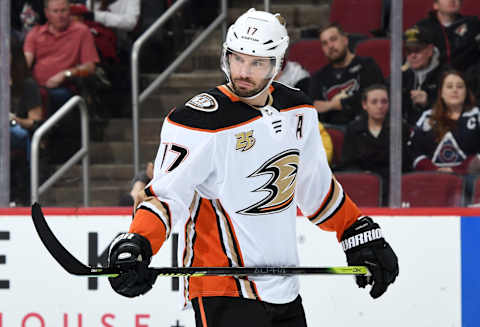
There are some very bad contracts around the NHL. Here’s a look at every team’s worst deal as the 2019-20 season slowly approaches.
In most professional sports, bad contracts aren’t the end of the world. You can just trade them, hide them in the minors, or they’ll be gone in about four or five years anyway. If worst comes to worst, you can always just buy them out. It’s not that easy in the NHL.
As the only one of the four major sports with a hard salary cap ceiling that isn’t skyrocketing every year, bad deals can ruin you in hockey. Unlike the NFL, which also has a hard cap, unless you buy out a player, their deal is still guaranteed. You can hide them in the minors, but that only gives you minimal relief.
More from Puck Prose
- Detroit Red Wings 2023 Rookie Camp Has Plenty of Ups and Downs
- This Columbus Blue Jackets rookie doesn’t want to be forgotten
- 2 trades the Boston Bruins must make to secure the Stanley Cup
- 3 reasons the Avalanche won’t win the Stanley Cup in 2024
- This is a big year for Alex Turcotte and the Los Angeles Kings
Bad deals in the NHL can cost teams for years. Not just in terms of money. It could also make them get rid of players because they can’t afford them because they have to give some third-pairing defenseman $6 million. And unless that player on a bad deal suddenly become allergic to hockey equipment, you’re stuck with them. Unless you can find a bad general manager to take on your mistake.
For this exercise, I took a look at a player’s production, their likely career trajectory, age, market value, and any no-movement clauses or no-trade clauses. Signing bonuses don’t really matter to me because you’ve got to pay players one way or another. A signing bonus just makes you do it a little bit earlier. Since owners are very wealthy, I don’t think that’s an issue.
I’ve already taken a look at the best contracts. If you prefer happy things, that’s the article for you. For the rest of you misery-loving hockey fans, here’s each team’s worst contract entering the 2019-20 season.
All contract information is from Cap Friendly. Stats are from Hockey Reference, Natural Stat Trick, and Evolving Hockey.
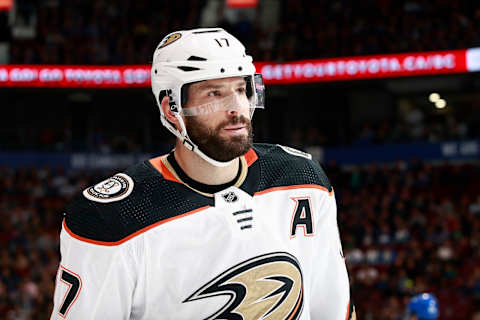
Anaheim Ducks – Ryan Kesler
Contract: $6.875 million cap hit over three years; NMC for the next two seasons, modified NTC for the third season.
When the Anaheim Ducks signed Ryan Kesler, they signed the deal knowing it probably wasn’t going to end well. The Ducks were hoping they would win a Stanley Cup in his early years, which would distract everyone from his long-term deal. They did not win a Stanley Cup and their optimism that Kesler would be good in his early years was misguided.
The first season (2016-17) of his deal actually went well. Kesler had 58 points, his most productive season since the 2010-11 season with the Vancouver Canucks. Since then, his production has fallen off a cliff, mostly due to injuries and old age.
- 2017-18: 44 games, 14 points
- 2018-19: 60 games, 8 points
Related Story. Top 10 Ducks Prospects. light
There’s a good chance Kesler won’t play during the 2019-20 season. It’s plausible he will never play another game in the NHL. You could argue the Ducks can put him on the long-term injured reserve list so his cap hit magically disappears during the season. And you might be right. But what does it say about his contract if him not playing might be a good thing for the team?
Dishonorable mentions: Cam Fowler has been awful since signing his long-term deal. That said, I’m not sold he’s done quite yet. Very few players did well in Randy Carlyle’s system. It wouldn’t surprise me if new head coach Dallas Eakins helps Fowler bounce back.
Patrick Eaves has only played nine games since signing his big deal, but to be fair, it’s largely because he has a serious health condition. It’s hard to blame the Ducks either, as they didn’t know about it before he signed.
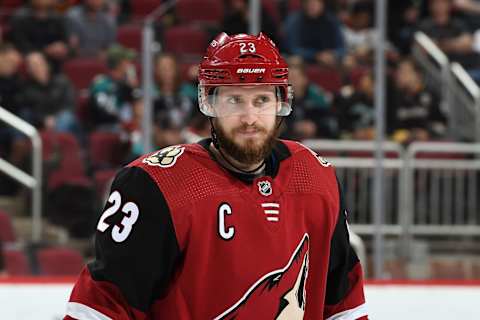
Arizona Coyotes – Oliver Ekman-Larsson
Contract: $8.25 million cap hit over eight years; no-movement clause all eight seasons
This might seem like an odd pick, but remember, the Arizona Coyotes are a funny team. Only 14 players are signed past the 2019-20 season. And only six are signed past the 2020-21 season. Most of their long-term deals are at worst decent values. OEL’s deal stood out to me as the worst one.
Ekman-Larsson is a perfectly capable defenseman. He’s at worst a top-four defenseman and his deployment is sub-optimal for a defenseman with his skill set. But still, if you’re getting paid $8.25 million a year (the fourth-highest cap hit among all defensemen), you’ve got to be a top pairing caliber defenseman. OEL’s results suggest he falls short of that high bar.
It probably has more to do with his lack of quality teammates than anything else. Having success is hard when the guys around you aren’t good. And OEL’s deal is one I’ll always defend. The Coyotes had to re-sign him. Losing OEL would have been disastrous. That said, Ekman-Larsson has to be better if the Yotes want to take a big step forward and get close to making the postseason.
Dishonorable mentions: Only having seven points in 20 games the year before his long-term deal begins certainly isn’t good for Christian Dvorak.
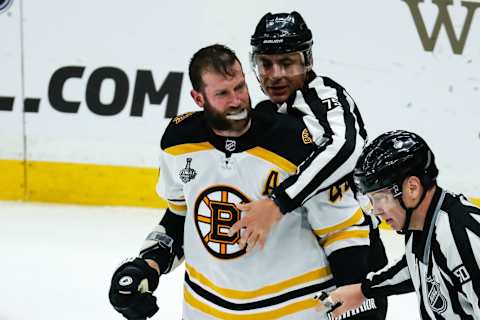
Boston Bruins – David Backes
Contract: $6 million cap hit over two years; $4 million signing bonus; modified NTC each of the last two years
I know I said I wasn’t going to care about signing bonuses, but David Backes is an exception. The only time signing bonuses matter is with buyouts. Bonuses make it more difficult to buy someone out because their bonuses are guaranteed no matter what. Backes’ signing bonuses might be the biggest reason why the Boston Bruins haven’t bought him out.
A buyout wouldn’t really give the Bruins much as far as cap relief. It would only save them $333,333 for the 2019-20 season. $6 million is a very large cap hit for someone who found himself as a healthy scratch during the postseason and regular season.
Related Story. Top 10 Bruins Prospects. light
During the 2018-19 season, in 70 games, Backes put up 20 points. It was the fourth straight season he saw his point total decline. At 35 years old, Backes’ days as a productive player are done.
Luckily, Charlie McAvoy can’t sign an offer sheet because he has only accrued two NHL seasons. And nobody appears to be interested in giving one out to Brandon Carlo. So Backes deal shouldn’t hurt them directly – for now. But you could argue his contract was why they couldn’t bring back Marcus Johansson, who did very well for the Bruins in the Stanley Cup Playoffs.
Dishonorable mentions: On paper, John Moore’s $2.75 million cap hit doesn’t seem too bad. But then you realize he’s still under contract for the next four years.
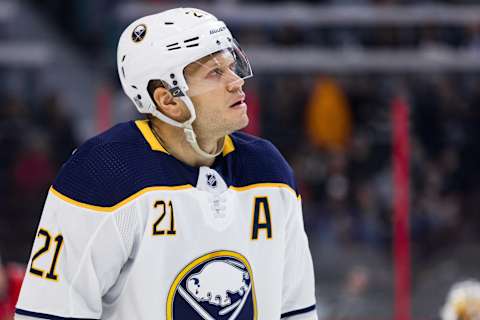
Buffalo Sabres – Kyle Okposo
Contract: $6 million cap hit over four years; $8 million signing bonuses; modified NTC in each of the last four seasons
The summer of 2016 saw a ton of NHL free agents sign long-term deals. Very few of them have worked out. The Buffalo Sabres, needing some scoring, hoped that Kyle Okposo could still be a good player away from John Tavares. That hasn’t been the case.
His first season actually went fairly well – Okposo had 45 points in 65 games. Then he had 44 points in 76 games during the 2017-18 season. Okposo’s decline got ugly in 2018-19, as he finished the year with just 29 points in 78 games, the lowest he’s had in any season with at least 50 games played.
Injuries have severely affected Okposo’s game. At one point, he had to be admitted to the hospital due to concussion symptoms. Okposo was named to the All-Star team just months before that, so it’s not a stretch to say a concussion probably sent his career into its current decline.
Currently, he’s being paid like a second-line forward. Okposo is not producing like one, nor is he even playing the minutes of one. His playing time got cut from over 17 minutes per game to just over 13 per game in the span of one season.
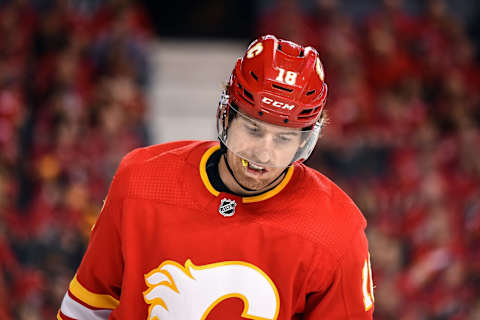
Calgary Flames – James Neal
Contract: $5.75 million cap hit over the next four years
The Calgary Flames signed James Neal last season, hoping to add a proven goal scorer and playoff performer to a roster that needed some help scoring. I’ve got good news and bad news. The good news is the Flames fixed their scoring issue, going from 26th in the NHL in scoring to second. But the bad news? Neal had very little to do with it.
Before the 2018-19 season, he had never scored fewer than 20 goals in a single season. During the 2018-19 season, Neal scored a career-low seven goals with 19 points (another career-low).
Maybe it was just a down year. Or maybe Neal’s decline just started and it will be ugly from here on out. He turns 32 in October and age is rarely kind to those who are over 30. There are those who are the exceptions to the rule, but assuming a player will bounce back past the age of 30 usually isn’t a good bet.
If you’re looking for some optimism Flames fans, at least there aren’t any NMCs or NTCs involved in this deal. Nor are there any signing bonuses. But on the other hand, it’s not a front-loaded or back-loaded deal. It’s $5.75 million of salary due each year for the next four. If it was a front-loaded deal, you could at least move him to a team looking to reach the salary cap floor. But that’s not the case. The Flames have to hope Neal bounces back.

Carolina Hurricanes – James Reimer
Contract: $3.4 million cap hit over the next two years
The Carolina Hurricanes have purged themselves of their bad deals. Victor Rask was sent to the Minnesota Wild for Nino Niederreiter, who has been a perfect fit on their top line. Scott Darling was sent to the Florida Panthers, who bought him out. In return for him, the Hurricanes had to take on backup goaltender James Reimer. He has the worst contract on the Hurricanes.
Now, Reimer has a good resume, so maybe last year was merely a blip. And, for what it’s worth, his best years have come as a part of a goaltending tandem and the Hurricanes have one. However, Reimer was undeniably bad last year and his numbers have been declining for two straight years.
- 2016-17: 43 games. .920 save percentage
- 2017-18: 44 games, .913 save percentage
- 2018-19: 36 games, .900 save percentage
What’s most concerning, though, is his age. Reimer is 31 years old. Age is very rarely kind to goaltenders, especially those who have bad years. You don’t see goaltenders bounce back too often after they hit 30 years old. And if they do, it tends to not be that significant of a bounce back.
The Hurricanes have options, though. They could send him down to the minors and call up Alex Nedeljkovic or Anton Forsberg. Thanks to a signing bonus in his final season, a buyout would be tough on the Hurricanes.
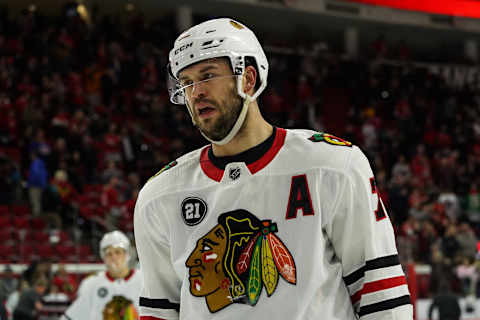
Chicago Blackhawks – Brent Seabrook
Contract: $6.875 million cap hit over the next five years; full NMC for the first three seasons, modified NTC (five-team trade list in 2022-23, 10-team list in 2023-24)
There isn’t a contract in the NHL worse than Chicago Blackhawks defenseman Brent Seabrook’s. Everyone knew it was going to be a bad deal before the ink dried. The Blackhawks signed him in September the year before he was scheduled to hit free agency.
You know that moment when you can tell a franchise starts turning in the wrong direction? Well, for the Blackhawks, that moment happened when they signed Seabrook. Since that contract was signed, they haven’t won a postseason series. The Blackhawks have had two first-round exits (including a sweep by the Nashville Predators) and have missed the playoffs in two straight seasons.
light. Related Story. Blackhawks All-Time Dream Team
They should have seen all the warning signs. First of all, Seabrook was 30 when he signed his deal, and it didn’t go into effect until he turned 31. Anytime you give a long-term deal to someone who is over 30, you assume a ton of risk.
Now, if the Blackhawks wanted to reward Seabrook for helping them win three Stanley Cups, that’s understandable. But why give him such a huge AAV? The whole purpose of handing out NMCs and NTCs is so you can keep the cap hit reasonable. That’s not what happened with Seabrook.
His contract is virtually buyout proof thanks to signing bonuses. Thanks to his signing bonuses, NMC, and later NTCs, it will take nothing short of a minor miracle to dump his contract onto another team.
Dishonorable mentions: A good sign you have a bad deal is your team has been actively trying to get rid of your deal and they can’t. That’s the case with Artem Anisimov.
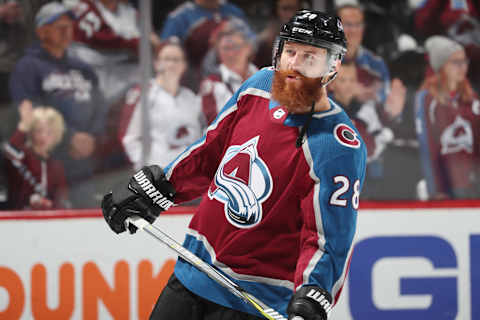
Colorado Avalanche – Ian Cole
Contract: $4.25 million over the next two seasons
The Colorado Avalanche are a well-built team. Look at their CapFriendly roster. It is full of beautiful, reasonable contracts. However, Ian Cole’s contract sticks out like a colorful rainbow in a black and white world.
It’s not so much that his contract is terrible, because $4.25 million isn’t a terrible price. My issue with the deal is it’s completely unnecessary. The Avalanche’s defense is fast and mobile. Cale Makar, Erik Johnson, and Samuel Girard lead their blueline. Cole doesn’t fit in with what they’re trying to do.
If Conor Timmins is healthy, he could be playing more minutes than Cole by the end of the year. That said, he does bring a few good things to the table. Cole is a very solid penalty killer and he brings a physical presence to their blueline. But you can find guys who can do that for a much cheaper price. Just look at Nikita Zadorov.
However, the Avalanche aren’t going to have any cap space issues for a while. So Cole’s contract, in a vacuum, isn’t the worst thing in the world. He’s one of Joe Sakic’s very few mistakes. If your biggest mistake is slightly overpaying a third-pairing defenseman, you’re doing a pretty good job.
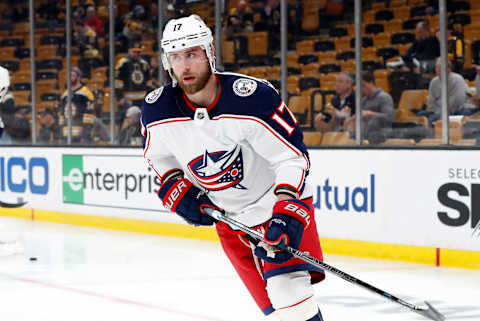
Columbus Blue Jackets – Brandon Dubinsky
Contract: $5.85 million cap hit over two years; NMC, 10-team no-trade list
The Columbus Blue Jackets are in the midst of a transitional period. They’re still figuring out what they’re going to do without Artemi Panarin, Matt Duchene, Ryan Dzingel, and Sergei Bobrovsky. Those guys are huge players to lose.
Brandon Dubinsky’s deal is the worst one on the team for several reasons. First of all, unlike a majority of the Blue Jackets roster, he’s not young. Only five of their players will be at least 30 years old when the season starts. Dubinsky, at 33 years old, is their oldest player. He’s also one of their least effective.
According to Evolving Hockey‘s GAR stats, Dubinsky had the lowest WAR (-0.5) of any Blue Jackets player during the 2018-19 season. After he put up just 16 points during the 2017-18 season, Columbus was hoping he’d bounce back. Instead, Dubinsky had just 14 points.
His deal doesn’t have any signing bonuses, so that’s a good thing. A buyout is at least feasible. However, because Dubinsky’s salary is $5.85 million every year, that makes it harder for them to trade him to a cap floor team.
Dishonorable mentions: What the heck happened to Alexander Wennberg? He’s only two seasons removed from a 59 point season. Since that season, Wennberg has a combined 60 points in two seasons over 141 games.
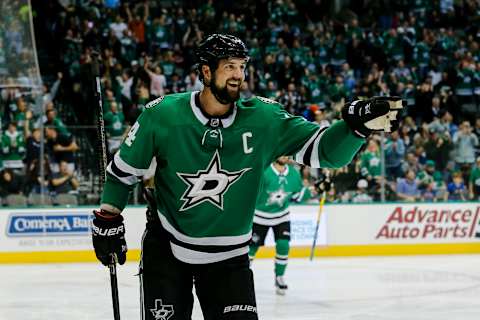
Dallas Stars – Jamie Benn
Contract: $9.5 million cap hit with six years left; full no-movement clause
To be clear, I think Jamie Benn’s deal is good for now. The Dallas Stars are in “win now” mode and Benn should help them do that. However, it’s not going to look good down the road. In fact, it could get ugly very quickly.
Benn is a physical forward. Those kinds of players tend not to age well unless they can adapt. Alex Ovechkin is a terrific example of a player who successfully adapted to a less physical playing style. Benn could follow in his footsteps, but there’s a key difference between Ovechkin and Benn – the former is much more skilled than the latter.
What’s particularly frightening about him is his production. Last season, Benn had 53 points in 82 games, plus 10 points in 13 postseason games. Combined, that’s 63 points. The last time Benn had a combined 63 points in a season? 2010-11. But he played in just 71 games that season.
You have to go all the way back to 2009-10 to find a less productive season from Benn (41 points in 82 games). That, by the way, was his rookie season. Benn will be 30 years old before the 2019-20 season begins. He should remain a productive player for the next few seasons.
But if Benn doesn’t, his contract will be next to impossible to get rid of thanks to his NMC and his signing bonuses ($40 million of the remaining $50 million on his contract is allocated to signing bonuses).
Dishonorable mentions: Three years and $7 million for Joe Pavelski is a tad bit much, but his recent history suggests he’ll be productive for at least two of those years if not all three. Martin Hanzal’s $4.75 million cap hit isn’t pretty, but he’s probably not going to play in the NHL again. Also, he only has one year left.
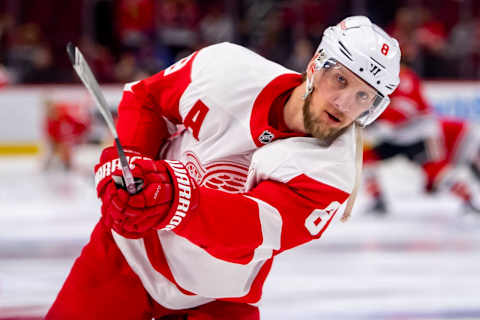
Detroit Red Wings: Justin Abdelkader
Contract: $4.25 million cap hit over the next four seasons; Full no-trade clause until 2020, modified no-trade clause (depending on if Red Wings make playoffs and playing time) through 2023
The Detroit Red Wings used to be the model of consistency in the NHL. In order to remain that way for a few more seasons, general manager Ken Holland signed a bunch of bad deals. None of them look worse right now than Justin Abdelkader’s.
According to Evolving Hockey, his -1.4 WAR was not only the second-worst among all Red Wings skaters, but it was also the eighth-worst in the entire league (minimum 800 minutes during all situations).
Top 10 Red Wings Prospects. light. Related Story
Abdelkader has never been much of a possession driver, so he’s had to rely on his production. His production has never been great, but last season, he had just 19 points in 71 games.
There could be a way out of it, though. Abdelkader’s full no-trade clause (how in heaven’s name did he get one?) runs through the end of the 2019-20 season. After that, he has what might be the most interesting modified NTC in the NHL – Abdelkader can be traded to any team if either of these two conditions are met.
- Red Wings don’t make the postseason
- Abdelkader is not in the top nine among Red Wings forwards in average TOI per game
At 15:24 per game, he was eighth among forwards in average TOI per game. However, Filip Zadina was at 15:23 and Taro Hirose was at 15:18. So it’s entirely possible that condition comes true, even if the first one doesn’t. This resets after each season, by the way.
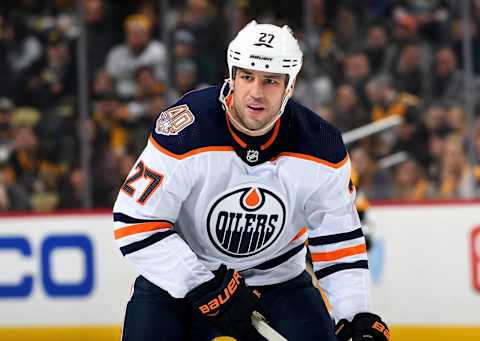
Edmonton Oilers – Milan Lucic
Contract: $6 million cap hit over the next four seasons; full no-movement clause; eight-team trade list in 2021-22, 10-team trade list in 2022-23
The Edmonton Oilers traded Taylor Hall back in 2016. That alone was a terrible move, as he went on to win the Hart Trophy while Adam Larsson has been mediocre at best. A consequence of this move was the eventual signing of Milan Lucic to replace him.
Let’s compare how Lucic and Hall have done since that fiasco.
- Hall – 181 games, 70 goals, 113 assists, 183 points
- Lucic – 243 games, 39 goals, 65 assists, 104 points
But hey, points aren’t everything, right? Let’s compare them by Evolving Hockey’s WAR.
- Hall – 7.7 WAR
- Lucic – -0.3 WAR
It’s clear the Oilers should have just kept Hall and not signed Lucic. Edmonton should have seen all the red flags. The NHL was transitioning to a speed game, where fast players dominate. Lucic isn’t fast.
Yes, he was productive. But even then, Lucic needed to be with the right players to be productive. Aside from a first-year that was saved by his power-play production, he hasn’t come close to living up to his contract. Now, even when Lucic gets to play with Connor McDavid, who is the best player in the league, he doesn’t produce.
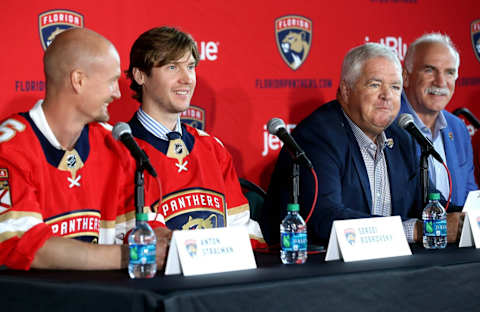
Florida Panthers – Sergei Bobrovsky
Contract: $10 million cap hit over the next seven years; full no-movement clause; 16-team no-trade list starting in 2024-25 (year six)
It’s not a question of if the Florida Panthers will regret signing Sergei Bobrovsky. Rather, it’s a matter of when they will. And trust me, the Panthers will, at some point, be handcuffed by his deal. They are hoping Bobrovsky helps them win a Stanley Cup or two before that point. If he does, his deal will look a little bit better. But if Bobrovsky doesn’t, his deal will be remembered poorly.
There are so many red flags with his contract. First of all, Bobrovsky’s a goaltender who turns 31 in September. Goalies over 30 typically do not age well. While it’s worth pointing out Bobrovsky has put up impressive numbers and could very well defy Father Time, goalies who can do that are the exception, not the rule. It would be foolish to assume he will. At best, it’s more like you hope he will.
Related Story. 3 Reasons The Panthers Will Regret Signing Bobrovsky. light
I get why the Panthers signed Bobrovsky. They really needed a goaltender and Bob was the most accomplished one on the market. However, he’s the second-highest-paid goalie in the NHL right now. Even if Bobrovsky bounces back from his worst regular season in years, he likely isn’t going to be the second-best goalie in the NHL.
This signing makes even less sense when you remember the Panthers went out of their way to draft Spencer Knight in the first-round of the 2019 NHL Draft before signing Bobrovsky. Signing Robin Lehner to a two-year or three-year deal would have made sense. Instead, the Panthers have to hope Bobrovsky is one of the few goalies who can avoid Father Time. The odds are against him.
Dishonorable mentions: At $4.875 million a year, defenseman Michael Matheson doesn’t have a very high bar to clear to live up to his contract. The bar’s pretty much on the floor. Matheson still hasn’t reached it.
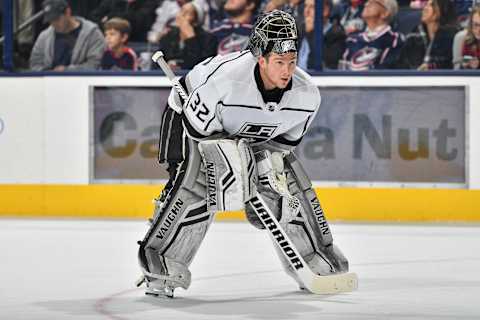
Los Angeles Kings – Jonathan Quick
Contract: $5.8 million cap hit over the next four years
The Los Angeles Kings are an aging team who needs to rebuild. Their roster is full of long-term deals to old players. Jonathan Quick has the worst of the bunch, though. On paper, Jeff Carter’s looks worse. But when you consider a few things, Quick’s is worse.
First of all, the Kings signed a goaltender to a 10-year deal. That’s never a good idea, even for the best goalies. The Kings were smart to keep his cap hit reasonable, but still, Quick hasn’t lived up to his contract. Even with the Stanley Cup he won during it (plus an additional one he won after signing the deal but before it went into effect).
Secondly, the Kings have several cheap young goalie options. Jack Campbell has outperformed Quick over the past two seasons and he’s not even making $800,000 a year. For about roughly 12% of Quick’s cap hit, Campbell is providing more value.
Now, there is one redeeming quality about his contract – it should be relatively easy to move. First of all, Quick doesn’t have an NMC or an NTC. Secondly, his salary starts dipping after the 2019-20 season.
- 2020-21: $3.5 million
- 2021-22: $3 million
- 2022-23: $2.5 million
That could be attractive to a team looking to hit the cap floor. Quick is a great example of why signing goalies to long-term deals rarely works out in the long run. Like I said with Bobrovsky, it’s not a matter of if you will regret it one day. It’s a matter of when you will regret it.
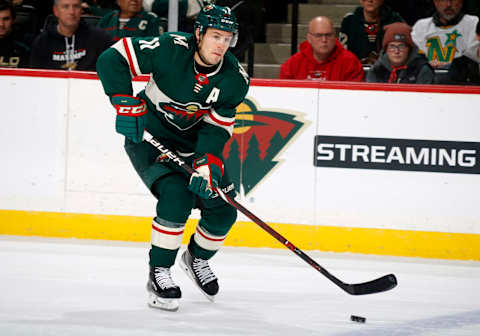
Minnesota Wild – Zach Parise
Contract: $7.538461 million cap hit over the next six seasons; full no-movement clause
Back in the summer of 2012, the Minnesota Wild made a franchise-altering decision when they signed Ryan Suter and Zach Parise to matching 13-year deals worth $7.538461 annually. It has worked out fairly well for them. However, even before the ink dried on the deals, people knew one day, those deals would look bad.
Credit Suter and Parise for living up to them, for the most part. However, the latter has struggled to stay healthy. When Parise is healthy, he has been as good as advertised. In 444 games with the Wild, he has 167 goals, 169 assists, and 336 points in the regular season. Parise has added 31 points in 36 postseason games.
275 forwards have played at least 300 games since the 2013 lockout. Parise ranks 42nd among them with 0.76 points per game. He’s ahead of some very good players, including Marian Hossa, Ryan Johansen, and Ryan Nugent-Hopkins.
However, Parise has played all of the games in a season just once since arriving in Minnesota. That was the 2013 lockout-shortened season when he played all 48 games. Since then, the most games he has played in any season is 74. Parise has played in at least 70 games just three times in the past six seasons.
Dishonorable mentions: Mats Zuccarello’s deal proves the Wild haven’t learned that long-term deals to players over 30 years old rarely work out. But consider this – when Zuc’s deal is up, Parise will still be signed for one more year.
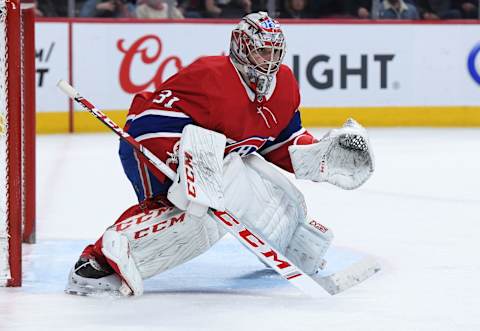
Montreal Canadiens – Carey Price
Contract: $10.5 million cap hit over the next seven years; full NMC
The Montreal Canadiens had to keep Carey Price. It cost them a lot to do it, but they signed in the summer of 2017 to the most expensive deal given to a goaltender in the salary cap era. This deal was doomed from the start, as Price was 31 years old when the deal began. And it came right after he had the worst season of his NHL career.
Even after a nice bounceback campaign, Price’s deal is a bad one at best. When he’s right, he’s one of the best goalies in the world. Price turns 32 years old in November, which makes you wonder how long he can continue to be one of the best goalies in the world. He hasn’t been the same since his groin injury back in the 2015-16 season.
My biggest concern about this deal actually has very little to do with Price. Well, it does, but it’s something he has very little control over. The Canadiens seem convinced letting Price start over 60 games a year is a good idea.
Related Story. Top 10 Canadiens Prospects. light
They’re doing this despite seeing how the Capitals back in 2017-18 and the Bruins (plus Hurricanes) in 2018-19 had success while managing their starting goaltender’s workload. Bad backup goaltending cost the Habs a playoff spot last season.
What did the Canadiens do about it? They signed Keith Kinkaid, who boasted a .891% save percentage last season, to a $1.7 million, one-year deal. Meanwhile, Curtis McElhinney, who has put up far better numbers, signed with the Tampa Bay Lightning, getting a $1.3 million cap hit over two seasons. Price is doomed and you can’t help but feel bad for the guy.
Dishonorable mentions: The only reason I didn’t have Karl Alzner on here is his cap isn’t horrible and they’ll be done with him soon.
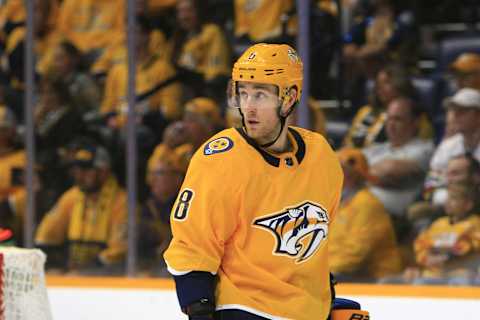
Nashville Predators – Kyle Turris
Contract: $6 million cap hit over five years
The Nashville Predators have tried a variety of options to solve their eternal second-line center problem. Eventually, they wound up getting the guy they wanted all along in Matt Duchene. But before him, the Predators thought Kyle Turris would be a solution.
In November of 2017, Nashville acquired Turris in a three-team trade (which, ironically, included Duchene going to a different team). They immediately signed him to a six-year deal worth $36 million. 20 months later, Turris has the worst deal on the Predators.
After finishing with 42 points in 65 games (a 53 point pace over 82 games) in his first season, things appeared to be going just fine. Then Turris had one of the worst seasons of his career. In 55 games, he had just 23 points. Turris’ 0.42 points per game were his lowest since the 2010-11 season. Despite having favorable deployment with a 67.6% offensive zone start percentage, he didn’t drive possession during the 2018-19 season.
Now, he’s the NHL’s most expensive third-line center. His contract is one of the reasons the Predators had to trade P.K. Subban. Turris could bounce back, as his resume is a strong one. The Predators better hope he bounces back or things could get mighty ugly in Nashville. At least his deal doesn’t have an NMC or an NTC.

New Jersey Devils – Cory Schneider
Contract: $6 million cap hit over three more years; full no-trade clause
Back in 2013, the New Jersey Devils were looking for a replacement for long-time franchise goaltender Martin Brodeur. They elected to go with Vancouver Canucks goaltender Cory Schneider, trading for him at the 2013 NHL Draft.
After a strong first season, they signed him to a massive seven-year deal worth $42 million in July of 2014. The deal began back in 2015. Since then, the contract has aged like milk left out of the refrigerator.
Related Story. 5 Key Devils For The 2019-20 Season. light
Schneider had a great season in 2015-16, posting a 0.924% save percentage. Then his inevitable decline came far earlier than the Devils expected.
- 2016-17: 60 games, .904% save percentage
- 2017-18: 40 games, .907% save percentage
- 2018-19: 26 games, .903% save percentage
He went over a full calendar year without winning a single regular-season game that he started. Schneider won a game he started in December of 2017 and didn’t win another regular-season start he finished until February of 2019 (though he got the win in a few games he was either pulled from or he replaced the other goalie).
Schneider is a good example of why long-term contracts for goaltenders are inherently risky. They can lose their mojo at any given moment. Somewhere along the line, Schneider lost his mojo and he hasn’t been the same ever since. He went from being a very good goalie to being a bad one in a few months.
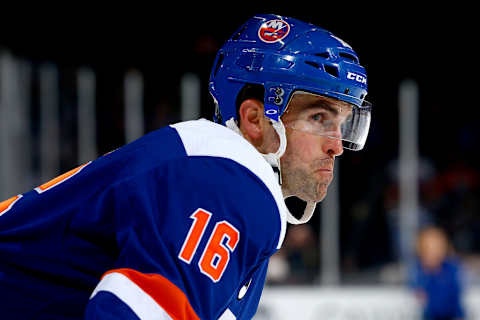
New York Islanders – Andrew Ladd
Contract: $5.5 million cap hit over the next four years; NMC for 2019-20, modified NTC (15-team no-trade list) for the remaining three seasons
Lou Lamoriello just can’t help himself in the offseason. He has to do at least one jaw-droppingly silly move. Anders Lee ($7 million cap hit for seven years) and Semyon Varlamov ($5 million cap hit for four years) both got contracts that will likely age poorly.
However, neither of those deals can hold the jockstrap of Andrew Ladd’s deal, which is a big reason former GM Garth Snow got removed from his position. Snow didn’t dive into free agency too often. Maybe the Ladd deal is why he rarely signed big-name free agents.
Ladd, like several other players on this list, was signed back in 2016. He was 30 at the time. This is a recurring theme. It’s almost like giving long-term, expensive deals to players over 30 years old is a dumb idea or something.
He has a total of 71 points in his first three seasons with the Islanders (177 games). Ladd has just 0.40 points per game with the Isles. Since signing his deal, this ranks 225th out of the 405 forwards who have played at least 100 games. Ladd has the 89th-highest cap hit among forwards, so that’s not a good deal. And it likely won’t get better, as his decline is hitting him hard.
Dishonorable mentions: I’d love to hear why the Islanders were willing to give a four-year deal to Varlamov, who has been injury-prone and inconsistent throughout his career, yet weren’t willing to give the same commitment to Robin Lehner. Lee’s deal is fine for now, but considering he’s not a very fast skater and he’s a physical skater, his contract is a bit worrisome.

New York Rangers – Brendan Smith
Contract: $4.35 million cap hit over the next two seasons; modified NTC (15-team trade list in 2019-20, 10-team trade list in 2020-21)
The New York Rangers have undergone a successful rebuild. By signing Artemi Panarin and getting lucky enough to draft Kaapo Kakko, the Rangers are ready to start making some noise. The only thing holding them back? An overpaid and crowded blueline. No Rangers defenseman is as overpaid as Brendan Smith.
Once they sign Jacob Trouba and Anthony DeAngelo, they will have eight defensemen on their NHL roster. That’s before factoring in guys like Ryan Lindgren, Sean Day, and Yegor Rykov, who could push for roster spots by the end of the year. Smith is clearly the odd guy out.
Since signing with the team in the 2017 offseason, he has found himself in the lineup just 118 games. The Rangers have even resorted to putting him on the fourth forward line.
Related Story. Top 10 Rangers Of All-Time. light
With a crowded blueline, Smith is a buyout candidate. The Rangers are likely going to arbitration with at least one player, so expect them to deeply consider buying out his contract.
Dishonorable mentions: Marc Staal ($5.7 million cap hit over two years with a full NMC) is overpaid and is aging. However, thanks to signing bonuses, his contract is a bit harder to buy out. But he’s at least a decent third pairing defenseman if used correctly.
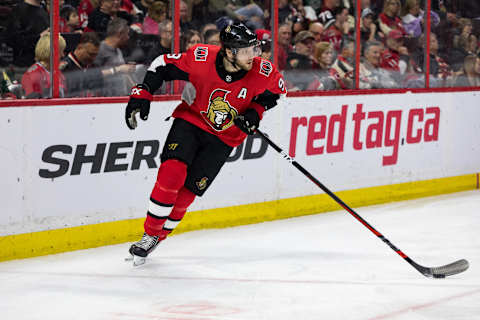
Ottawa Senators – Bobby Ryan
Contract: $7.25 million cap hit over the next three seasons; NMC, 10-team NTC.
The Ottawa Senators were looking for a new face of the franchise after Daniel Alfredsson left. They were betting on that guy being Bobby Ryan or Erik Karlsson. It turns out neither guy was. The latter left in a trade with an underwhelming return. Meanwhile, the former is still around but isn’t the forward the Senators thought they were getting.
At first, Ryan did fine. In the first year of his extension (2015-16), he posted 22 goals and 56 points. However, in the next three seasons, he has combined to score 39 goals with 100 points. Ryan has also missed 20 games in the first two seasons. Combined, he has played 202 games in those three seasons.
When healthy, Ryan’s actually been fairly decent. Among the 377 forwards with at least 150 games played since the start of the 2015-16 season, he ranks 145th. The issue is Ryan is paid to be a much better player than that. A budget team like the Senators needs guys like him to live up to their deals. Ryan isn’t doing it.
Also, his no-movement and no-trade clauses make it almost impossible for the Senators to get rid of him. Ryan’s deal is nothing short of an albatross.
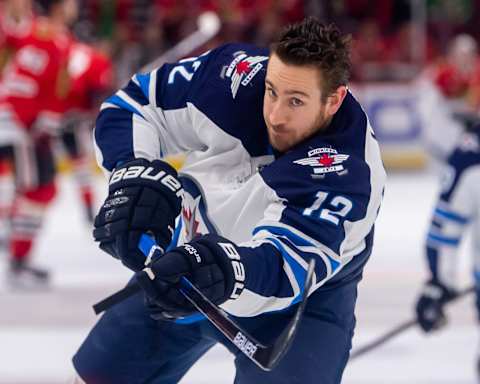
Philadelphia Flyers – Kevin Hayes
Contract: $7.142857 million cap hit over the next seven years; full NMC for the first three years, modified NTC (12-team no-trade list) for the next four
Before this year, the easy answer for the Philadelphia Flyers when the “worst contract” discussion came up was Andrew MacDonald. However, the Flyers bought him out this summer, so he’s no longer an option. This leaves Philadelphia with no ridiculous deals. However, Hayes deal, signed earlier this offseason, doesn’t look like a very good one.
It’s worth noting he’s 27 years old, so this deal should look better than most long-term deals signed in free agency. However, let’s take a look at Hayes’ career highs.
- Goals: 25 (2017-18)
- Assists: 36 (2018-19)
- Points: 55 (2018-19)
Related Story. Top 10 Flyers Prospects. light
Hayes has only reached the 50 point plateau once in his career – last season. However, he has gotten at least 40 points in all but one of his five career seasons, which isn’t too shabby. But is that worth over $7 million a year? Probably not.
That said, Hayes does bring a lot of value outside of production. He’s a pretty strong defensive forward who can drive possession on both sides of the ice, though he’s more effective at doing so on defense.
In a vacuum, Hayes deal makes sense. The Flyers needed a second-line center. Nolan Patrick clearly wasn’t the answer. The Flyers want to contend right now, so they had no real choice but to sign Hayes. There are far worse deals than his around the league. If Hayes’ deal is the worst one on your team, you’re in pretty good shape.

Pittsburgh Penguins – Jack Johnson
Contract: $3.25 million cap hit with four years left
Jack Johnson’s infamous five-year deal with the Pittsburgh Penguins was bad before the ink dried on the paper. I said this last summer, and Pens fans wanted to get him a chance. A year later, to quote The White Stripes, “hate to say I told you so”.
Johnson was even worse than expected last season. According to Evolving Hockey, among defensemen who played at least 1,000 minutes during all situations, he had the 15th-lowest WAR at -0.7. Johnson provided below replacement level value. They likely would have been better off claiming some guy off waivers and giving him Johnson’s role.
Now, that said, his contract must not be viewed nearly as badly around the league. Because the Penguins nearly traded him to the Minnesota Wild in the nutty Phil Kessel for Jason Zucker trade that Kessel rejected. And apparently, teams are interested in Johnson. Don’t ask me why that’s the case.
Dishonorable mentions: General Manager Jim Rutherford did not learn from his mistakes last summer. He signed Brandon Tanev, a bottom-six forward, to a six-year deal with a $3.5 million cap hit. Tanev is a pretty decent bottom-six forward, but giving him six years is outlandish. You don’t give that kind of term to bottom-six forwards.
Patric Hornqvist’s deal ($5.3 million cap hit over the next four years) looks fine – for now. But if you consider his physical playing style and his recent rash of injuries (namely concussions), it’s not to see how that deal could get ugly. Worst of all, Hornqvist has a full NTC for the next two seasons and an eight-team no-trade list for the two seasons after that.
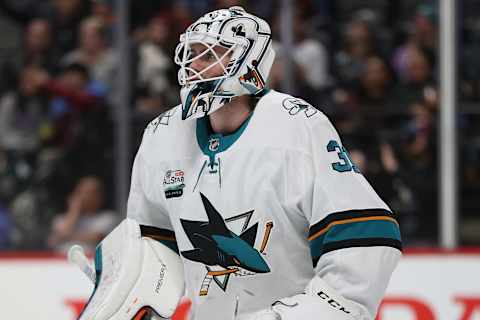
San Jose Sharks – Martin Jones
Contract: $5.75 million cap hit for the next five years; three-team trade list
Back in July of 2017, the San Jose Sharks signed Martin Jones to a six-year deal at just under $6 million a year. The deal went into effect at the start of the 2018-19 season. At the time, that didn’t sound too bad. Jones would be good for the first few years, right?
If that’s what you thought, you couldn’t have been more wrong. Last season, in the first year of his deal, Jones had a woeful .896% save percentage during the regular season. Among goalies who started at least 20 games last season, that was the fifth-worst save percentage. Backup Aaron Dell was even worse. Frankly, it’s a minor miracle the Sharks made the postseason despite having such awful goaltending.
Jones has a good resume, so there’s an outside chance he could bounce back. After all, goaltending is volatile and pretty unpredictable. But still, Jones is off to the worst possible start to his new contract. The Sharks will need him to be better next season.
Dishonorable mentions: Evander Kane’s deal is fine for now, but there will be a time when the Sharks regret signing him. Erik Karlsson’s deal could go down the gutter very quickly thanks to his injury history. But in fairness, they’re gambling on one of the best defensemen in the world. They should be fine.
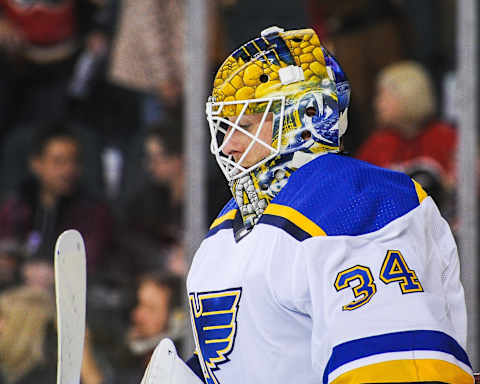
St. Louis Blues – Jake Allen
Contract: $4.35 million cap hit over the next two years
Give St. Louis Blues general manager Doug Armstrong some credit. He is excellent at avoiding the regrettable deals most of his peers hand out without even blinking. When Armstrong does hand out a bad deal (Jori Lehtera, Vladimir Sobotka, and Patrik Berglund come to mind), he finds a sucker to take on those deals.
Jake Allen’s deal, though, is probably the worst on the team. And honestly, it’s not even that bad. Allen is pretty much the definition of a league-average goaltender. He’ll frustrate you at times, but at the end of the year, check out his save percentage and compare it around the league. You’ll find he’s average.
Allen is getting paid a reasonable wage for what he does too. Also, having him around is important now. Jordan Binnington had a season to remember. Disney could not have scripted a better season for him. He went from an afterthought to leading the Blues to the Stanley Cup.
But, as we’ve learned through looking at bad deals, goalies are unpredictable. They go from great to bad in a span of a few months. Binnington might be great. Or he could wind up being a one-hit-wonder. He’s getting paid right around what Allen is.
Allen is the Blues security blanket in case Binnington struggles. And hey, having two league average goalies and playing whichever one of them has the hot hand isn’t an awful strategy. You just have to have two good goalies. The Blues might have that.
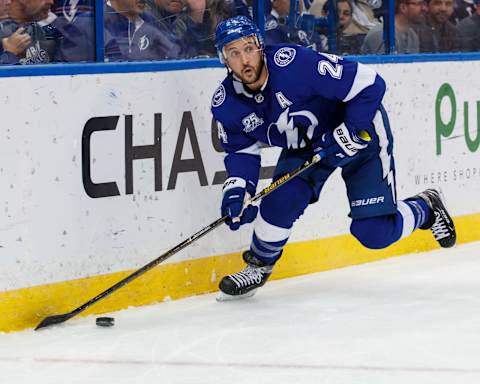
Tampa Bay Lightning – Ryan Callahan
Contract: $5.8 million cap hit with one year left; no-movement clause, modified no-trade clause
The Tampa Bay Lightning still haven’t turned up the difficult settings from “easy”. They talk guys into signing completely reasonable, or even below market-level, deals. Playing in a tax-free state certainly helps with that, but this is a sign of a good front office.
Back in 2014, Martin St. Louis got mad that he was left on Team Canada initially. Team Canada’s GM happened to be the Lightning’s GM, Steve Yzerman. This led to St. Louis privately asking for a trade. He was sent to the New York Rangers for Ryan Callahan.
Callahan had some red flags. First of all, he was nearing 30 years old when he signed his extension, which, if you’ve been paying attention, is an ingredient for a lot of bad contracts. Secondly, Callahan relied on a physical style of play, which tends not to age well. And, as expected, it didn’t.
Related Story. 3 Players The Lightning Should Trade. light
Callahan was actually pretty good in his first season (2014-15). He tied his career-high with 54 points and added 10 points in the postseason. That was the last time Callahan reached the 30 point plateau.
His deal doesn’t really hurt Tampa too much, as he likely won’t be playing hockey ever again. Still, it’s a bit of a pain in the butt to deal with in the offseason since the Lightning can’t put his deal on the LTIR during the summer.
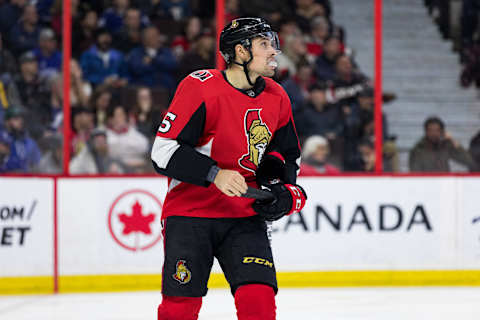
Toronto Maple Leafs – Cody Ceci
Contract: $4.5 million cap ht with one year left
Last year, the Toronto Maple Leafs had two bad deals – Nikita Zaitsev and Patrick Marleau. It shouldn’t surprise you Lou Lamoriello was the GM who signed both of them. The Leafs managed to purge their roster of both of them. However, to get rid of Zaitsev’s contract, they had to take on Cody Ceci’s deal. Ceci’s deal is slightly better than Zaitsev’s, but only because Toronto can say goodbye to Ceci in a year.
Why they even agreed to a deal with him is a bit baffling. Technically, the Leafs could have gone to arbitration with Ceci, as he was an RFA who elected arbitration. They could have butchered it as badly as possible, ensuring he would get a decent raise. Then, the Leafs could have just walked away from his award, as it likely would have passed the minimum cap hit required to do so.
Related Story. Top 10 Leafs Prospects. light
Ceci doesn’t do anything particularly well. He’s not a puck mover, nor does he show up on the stat sheet on a regular basis. Ceci’s teammates are far better without him on the ice than they are with him on the ice. That said, he was dealing with some bad linemates in Ottawa. The Maple Leafs don’t even need him to be good. Even just bearable would be fine.
By the way, people think William Nylander has a bad deal. He absolutely does not.
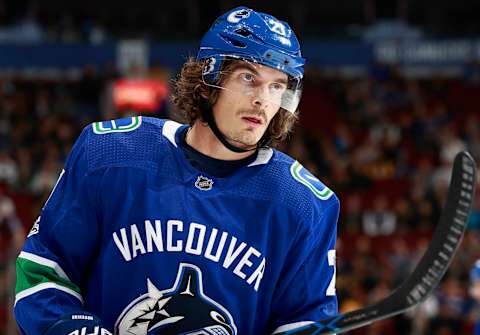
Vancouver Canucks – Loui Eriksson
Contract: $6 million cap hit over the next three years; full no-trade clause through 2020-21, 15-team no-trade clause from 2020-21 to 2021-22
General Manager Jim Benning has done a nice job drafting for the Vancouver Canucks. Unfortunately, he needs to be locked in a room without any cell phone service for 24 years starting at midnight on every July 1. Benning has a long list of bad moves made on that day.
Back in 2016, he made his worst July 1 decision when he signed Loui Eriksson to a six-year deal worth $6 million, throwing in a bunch of clauses and signing bonuses as well.
Unsurprisingly, that contract was bad from day one. Eriksson was 31 years old when he signed his deal. He was coming off a very productive season with the Boston Bruins. However, it’s worth noting Eriksson regularly played with Patrice Bergeron and Brad Marchand, who could probably take a homeless bum off the street and make him a 20 goal scorer.
Related Story. 3 Reasons The Canucks Can Make The Playoffs. light
In 196 games with the Canucks, Eriksson has 32 goals and 76 points. He scored 30 in 2015-16 with the Bruins. Eriksson hasn’t driven possession either, so he’s been providing very little for the Canucks.
Dishonorable mention: Tyler Myers got $30 million from the Canucks this summer. If it wasn’t for Eriksson, I’d easily have him as the worst deal in Vancouver. And guess what day Myers signed on? July 1.
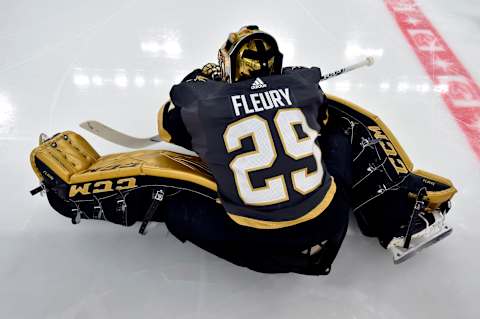
Vegas Golden Knights – Marc-Andre Fleury
Contract: $7 million cap hit over the next three years; modified NTC (10-team no-trade list)
Marc-Andre Fleury had a surprising year in 2017-18. It was his best season statistically. Fleury helped lead the Vegas Golden Knights to the Stanley Cup Final in just their first year as a franchise However, he didn’t repeat his performance in 2018-19. Fleury played like the aging goaltender he is, posting a .913 save percentage.
He turns 35 years old in November. Granted, this deal isn’t a long-term one. But still, three years is a bit much to commit to a goalie who has a ton of miles on his legs. On the ice, Fleury isn’t worth $7 million (though you could argue he has immense value off of it as the face of the Golden Knights). He’s the fourth-highest paid goalie in the league. Fleury is not the fourth-best goalie in the league.
Related Story. Top 10 Golden Knights Prospects. light
My primary concern with Fleury, much like Price, has to do with how he is being used. Fleury has been a workhorse his entire career. He started 61 games last season. That’s a bit high. The Golden Knights should look at what the Bruins did with Tuukka Rask. They signed Jaroslav Halak and he let them rest Rask. That kept him fresh for an extended run to the Stanley Cup Final.
If the Golden Knights trust Malcolm Subban a bit more and limit Fleury to about 50 games, that should do wonders for him and he might live up to this contract. Looking at how they have used him over the past two years, I don’t think that’s happening.
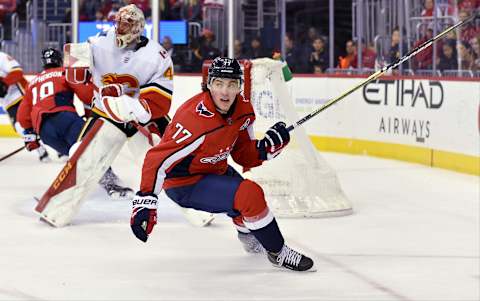
Washington Capitals – T.J. Oshie
Contract: $5.75 million cap hit over the next six years; modified NTC (15-team no-trade list) for the next two seasons, 10-team for the remainder of the deal)
T.J. Oshie signed a huge extension back in the summer of 2017. They kept the cap hit reasonable – $5.75 million is reasonable for a top-six forward – but the term always struck me as being a bit long.
When healthy, Oshie is a darn good player. 339 forwards have played at least 100 games over the past two seasons. Oshie is 86th among them in points per game with 0.71. This puts him as a borderline top-line forward in terms of production. The issue is, Oshie can’t stay healthy.
This has a lot to do with his concussion issues, sadly. Oshie has suffered no fewer than five concussions during his career. He has missed at least 10 games in two of the past three seasons, which is a bit alarming.
Related Story. Top 10 Capitals Players Of All-Time. light
Oshie helped the Capitals win the Stanley Cup, which helps justify his deal. But still, it’s hard to see this contract looking good long-term. Especially given his injury history. That said, Oshie’s deal doesn’t have an NMC and the league has proven they value guys like him. So if the Capitals need to get rid of the deal, they should have no issues doing so.
Dishonorable mention: Garnet Hathaway is a very solid fourth-liner who is one of the best penalty killers in the league. At $1.6 million, his cap hit is quite reasonable. But Hathaway got a four-year deal. You don’t give four-year deals to fourth-line forwards. For the same reason, I could see Carl Hagelin’s deal ending up looking bad if his speed leaves him.
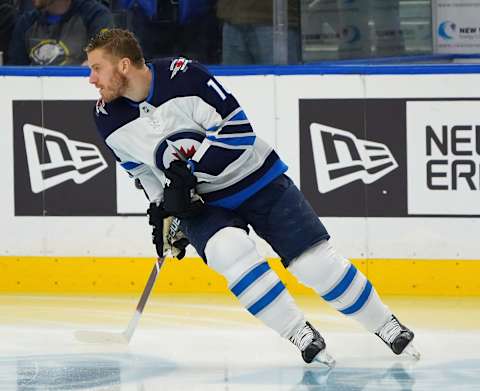
Winnipeg Jets – Bryan Little
Contract: $5.921666 million cap hit over the next five years; no-movement clause for the next season, modified no-trade clause (14-team no-trade list) for the last four
The Winnipeg Jets have been pretty good at avoiding bad deals. However, the Bryan Little contract sticks out like a sore thumb. You could argue Dmitry Kulikov’s deal is a worse value (and you might be right for the 2019-20 season). But here’s the thing – Little’s contract has four years left after this season.
Winnipeg is paying nearly $6 million a year for someone who hasn’t reached the 50 point plateau since the 2014-15 season. Granted, Little has hit the 40 point plateau in his last eight season and was on pace to pass it during the 2013 lockout-shortened season.
But still, that’s a lot of money to pay someone who has struggled to stay healthy. It’s worth pointing out Little has played all 82 games in each of the last two seasons. But other than those two years, the only time he’s done that was in 2013-14.
Next. Each Team's Best Contract. dark
Little used to be a decent possession driver, but has gotten worse over the last two seasons. For now, his deal is fine, but it’s not hard to see how this deal could go wrong.
Dishonorable mention: If Neal Pionk gets a deal longer than two years, it’s a bad deal. He’s done nothing to warrant a long-term deal.